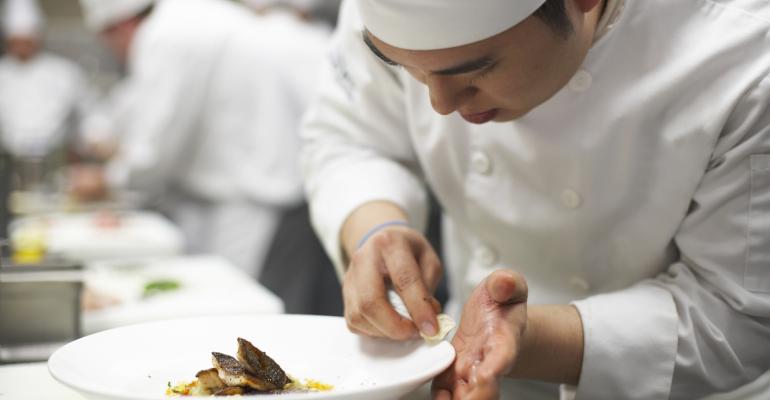Perhaps the singular most detail we all agonize over when we are having a dinner party is the menu — what we’ll serve, how it pairs with other menu items, who will enjoy it, whether there any special dietary needs or restrictions and how it will hold until the guests start to eat. Other things to consider are the equipment to produce the menu, whether we have the skill to execute and what it will all cost.
Restaurant operators stress over the same questions, with some added critical points: Why am I changing/adding to the menu? Do I need “one-off” ingredients? What existing menu items need to come off the menu, and how do I determine which items they are? Can my team replicate these items consistently?
Menu change is inevitable and foundational to the success of most restaurants. Restaurants need to be nimble and flexible and stay within their brand. This couldn’t be truer with the climate we live in today. Every restaurant is fighting for market share, and often their adaptation is additionally driven by their direct competition (think the “chicken sandwich wars”). Even the most iconic, longest lasting restaurants change their menus. When they do, the change is methodically decided by these and brand-specific questions.
One of the most often forgotten questions is this: Does this impact our ability to produce the menu in general? You see, proper menu design requires balance — specifically balance in terms of which station is tasked with producing the menu item and the stressors it puts on that station. If you add three items to the grill station, does the menu become too grill heavy to stay within desired service times? The right equipment and technology can offset the labor and skill level needed to execute.
Corporate restaurants have these answers down to a science. They build their menus on systems and structure. They know their systems are intertwined. They leave nothing to chance as they know slim margins depend on consistent execution down to the smallest detail.
Menu change for corporate restaurants is challenging. Considerations include product availability (what challenges will we have when sourcing and sustaining product, nationally and regionally?), item replication (can we replicate this item consistently regardless of location?) and guest acceptance/demand on a local, regional, national and global level.
Here are my tips on what chain restaurants can do to advance their menu innovation:
- Embrace the independent restaurant’s process and adapt to their program.
- Focus on regional trends and incorporate ingredients accordingly.
- Conduct onsite market analysis. Don’t rely on Google; get out into the marketplace. See what competitors are saying and doing.
- Connect with the community.
Guests are well trained on consistency, thriving on this attribute whether dining at a chain or a local, independent restaurant.
Years ago, I was speaking with an operator who was struggling despite being near a bustling army base. One of their main selling points, and the driver for their marketing strategy, was the local flair they offered. He felt that was something chains weren’t able to offer at such a granular level. I explained that they were struggling to gain market share not because of execution or what they served, but because they were fighting against familiarity more than anything. The army base residents, when not eating on base, sought out a restaurant that reminded them of home. Life choices impact people at many levels, we all find comfort in food and what reminds us of where we came from.
Menu innovation is different for independent restaurants. Independent restaurants focus on local, being unique (standing out from the crowd). They look to appeal locally. Flavor profiles are driven by tradition. Menu items may change more because the restaurant cannot purchase as well as the corporate restaurants; they do not have the volume purchases required to compete on price point.
Here are my tips on what independent restaurants can do to advance their menu innovation:
- Approach innovation systematically — understand the why behind what you want to do.
- Don’t rush to change for the sake of change.
- Develop a process that allows for trial and error. Get it right before a big roll out.
- Conduct focus groups.
- Connect with the community.
Oversimplified — OK, very oversimplified — there are two types of consumers: cost-driven and value-driven. Now one may think the latter is the less expensive option, but it isn’t. Value, when combined with price, drives perception (or price/value perception). Consumers look for their experience to match or exceed what they spend, and that goes beyond the menu. That goes directly to how the restaurant delivers on every level — décor, service, execution, attention to detail and, of course, quality and flavor of the food and drink.
Cost-driven consumers are primarily looking at what it costs to eat today. Can it really be that simple? The answer is yes. However, restaurant success is driven by complex questions and answers, focus groups (formal and informal), trial and error, data and analysis, marketing and staying on brand.
Menu evolution is needed to stay competitive, but it must be done methodically and with understanding what ripple effect that change will have on the bottom line.
AUTHOR BIO
Mark Moeller is founder and president of The Recipe of Success, a national restaurant consulting firm. For more information, visit recipeofsuccess.com.

